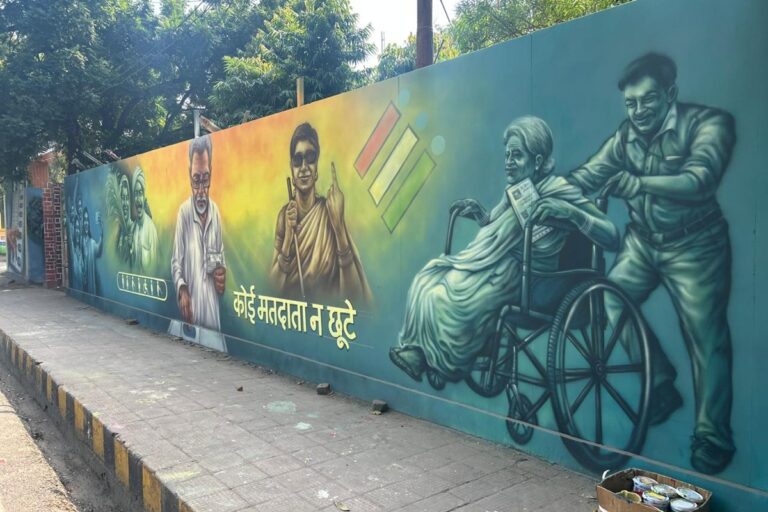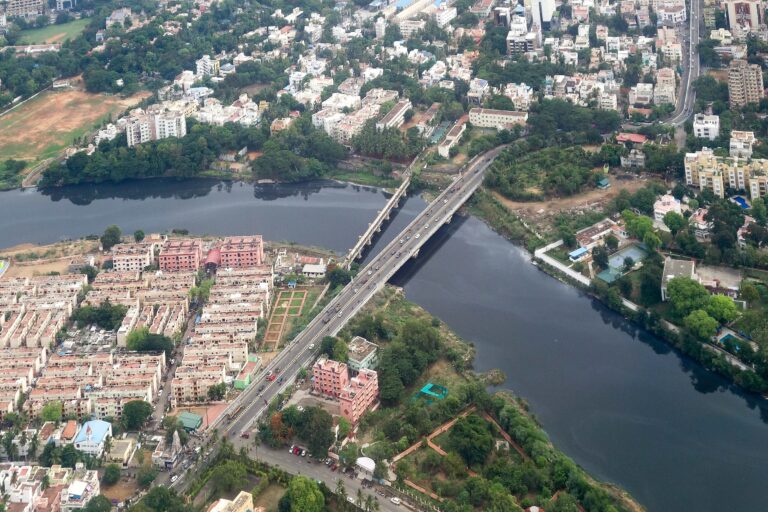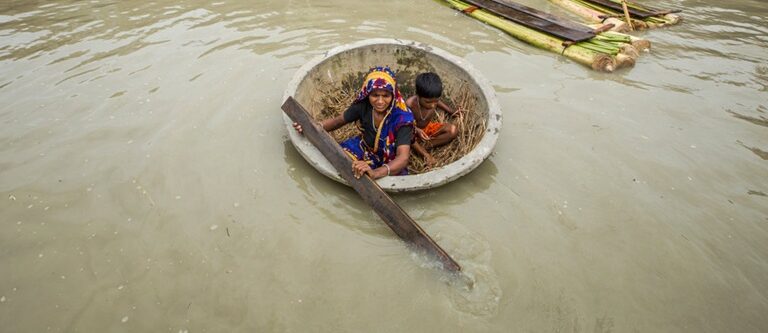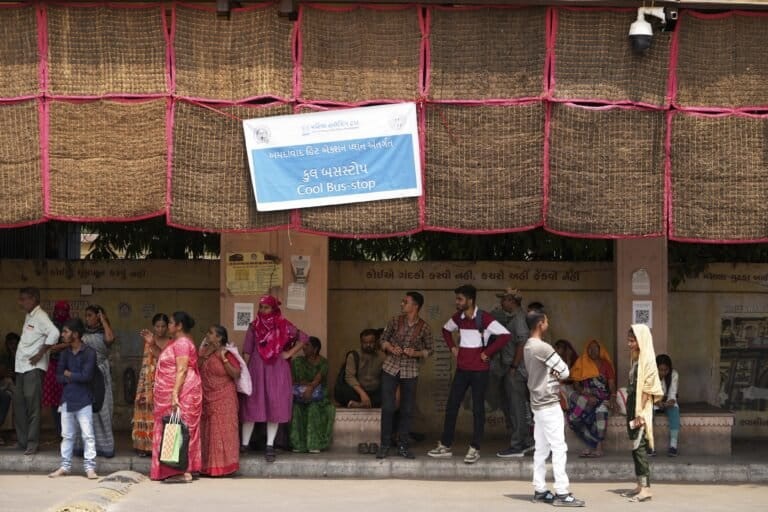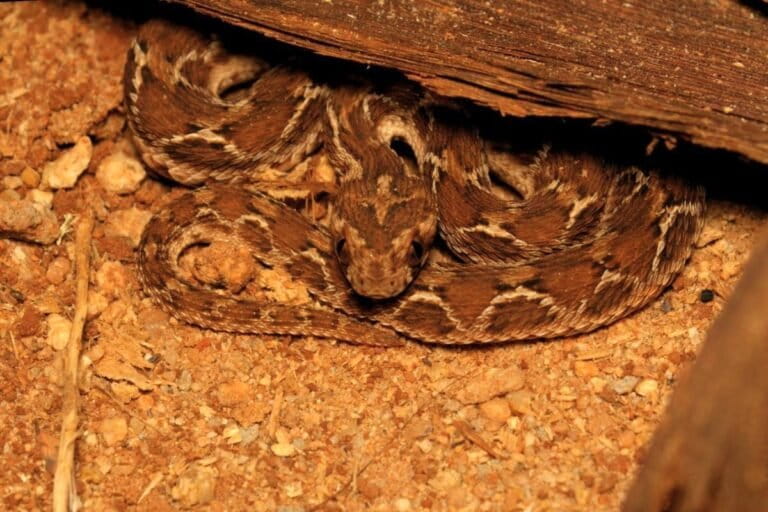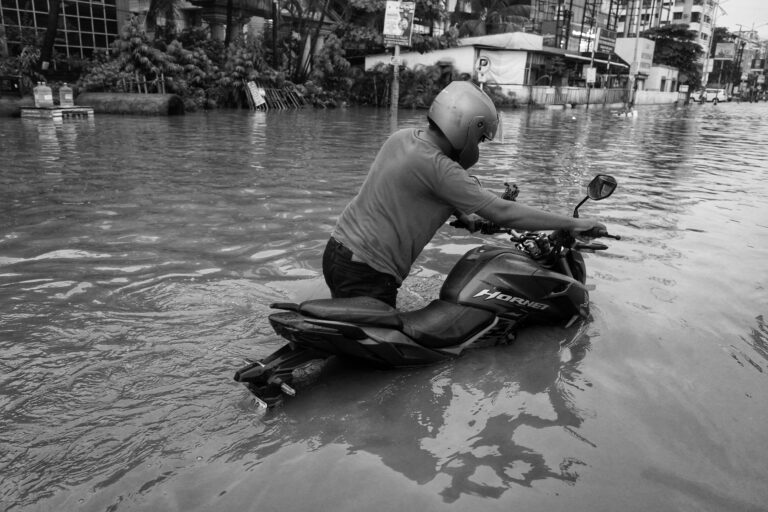- Surat’s textile industry is improving its manufacturing processes with efficient use of coal, electricity and water and by adopting renewable energy, to deal with the impacts of climate change and also be eco-friendly.
- While liquid effluents are being dealt with by following good practices, the use of fossil fuels and the generation of petrochemical-based fabric waste, still remain problems.
- Workers involved in steam-based operations are often exposed to high temperatures, which become too intense during summers.
- New technologies such as digital printing are safer for the planet and the health of workers, but high costs and just transition issues need to be addressed.
Sajida Sheikh’s job is to stitch wads of raw fabric that come for dyeing at Gujarat ECO Textile Park, a textile cluster at Palsana, in Gujarat’s Surat district. For 17 years, Sheikh, 45, has been walking six kilometres to and from Baleshwar, her village in Palsana’s neighbourhood. As the area is close to a creek, this walk becomes nearly impossible during monsoons. “We are compelled to take 10-12 days off during the rains. No proper drainage of creek water, results in the whole area getting flooded,” she says.
Sheikh is among the 1.4 million people employed by the textile industry in Surat. However, a sector that prides itself on being the second largest employer in the country after agriculture, is facing the brunt of climate change. In turn, the energy and water-intensive processes in textile manufacturing also contribute to the problem.

Hazardous chemical discharge from textile factories is another disturbance for a segment of workers. “Every house in my village has a cancer patient. Even my brother was diagnosed with cancer last month. Sometimes the wind is so laden with chemical smell that it is difficult to sleep. Even though we depend on textiles for jobs, we know now that it comes at the cost of health,” Sheikh adds.
The Surat textile industry, mostly comprising micro, small and medium enterprises (MSMEs), are responding by modifying manufacturing processes with the efficient use of coal, electricity and water and by adopting renewable energy. Some new technologies, although environment-friendly and safer for health, come at a cost and with the catch of reduced employment, making the transition unfashionably slow.
Surat’s textile industry
India is the second largest producer of synthetic fabric and the third largest exporter. In 2021 there were more than 40,000 textile units in Surat, with an annual turnover of 68,000 crores. Surat also produces 30 million metres of raw fabric and 25 million metres of processed fabric every day. There are six lakh power looms and 450 processing-dyeing and printing units in Surat’s industrial clusters of Pandesara, Sachin, Kadodara and Palsana. According to the last population census in 2011, 55% population of the city is composed of migrant labour from Uttar Pradesh, Bihar and Odisha, most of them engaged in the textile sector.
On the flip side, the industry is responsible for an estimated two to eight percent of the world’s greenhouse gas emissions and accounts for nine percent of annual microplastic losses to the oceans. World over, around 215 trillion litres of water per year is consumed by the industry out of which six to nine trillion litres is consumed only for fabric dyeing. Surat generates 1,800-2,200 tons garbage every day and about seven percent of this is ‘chindi’ (textile waste). Synthetic fibre is a petro-chemical product and the waste is either burnt or used up in boilers of textile processing industries.
“There is pressure from international brands to mitigate emissions and follow the best environmental compliance standards. It is only in our interest to change, but there are hurdles such as lack of sustained clean fuel sources and workers’ resistance,” shares Dharmesh C. Kachiwala, Director, J.P. Kachiwala Textiles Private Ltd. in Gujarat ECO Textile Park.

Climate impact
Sandwiched between the Arabian Sea and the Ukai dam located 94 kilometres upstream, Surat is prone to flooding both from the creek as well as the dam overflow. In the 2006 flood, when 75% of the city was inundated, the textile sector suffered a loss of Rs. 20 billion, reports a study “Flood-induced economic loss and damage to the textile industry in Surat”. A one-metre sea-level rise can swamp 40% of the land in Surat, it says.
“Workers in textiles, mostly migrants, stay in slums that are located along the creeks and river embankment. They not only lose workdays but also face the risk of vector-borne diseases. Floods also affect the transportation of raw material between MSMEs that feed each other like spinning, weaving and processing,” Mehul Patel, Program Lead, Climate at World Resources Institute (WRI)-India, tells Mongabay-India. WRI India is supporting 50 dyeing and printing MSMEs in Surat to deal with the changing scenario as part of its project ‘Resilient, Inclusive and Sustainable Enterprises’.

Proximity to the sea also means high humidity, in coastal cities like Surat. The India Meteorological Department states that when the maximum temperature crosses 39°C in Surat, a heatwave can be declared. The Climate Adaptive and Gender Integrated Heat Wave Action Plan of Surat City reports that the incidences of temperature going above 40°C have increased in the decade of 2011-2021. “Heat stress reduces labour productivity and can exacerbate poverty. The risks to human lives as a result of heat grew significantly in Surat in recent years,” the plan reads.
“Most dyeing and printing units operate from cramped rented spaces. Labour operates in 12-hour shifts. In the noon, workload is at peak and so is the temperature. The maximum number of people are inside and all machines are operational. Therefore, the thermal discomfort is high too,” explains Vishwajeet Poojary, Senior Program Associate at WRI India.
MSMEs say that adaptive measures such as extended lunch breaks, introducing earlier work hour shifts, putting gunny bags on asbestos roofs and installing vents and coolers wherever possible, are being taken. “We distribute butter milk and cold-drinks but the fact is that most operations are heat-based,” shares Kachiwala.

Steaming problems
Ram Prakash Sahoo spends most of his waking hours standing near a loop steamer, where the colours of freshly printed fabric are fixed by steam under high pressure and high temperature. “Standing for 12 hours a day in this heat is not easy. During summers, people even fall unconscious. Through the years, the number of machines have increased, cramping the space and releasing more heat. There is no ventilation and even the ceiling fan throws hot air. It’s like operating inside a pressure cooker,” he says.
“Sometimes, when fabric gets stuck in the loop steamer, we have to enter the machine. The machine is switched off and the steam is released for 15-20 minutes. Despite that, the temperature is not less than 150 degrees when we enter. If any body part touches the machine, it burns,” Sahoo tells Mongabay-India. Occupational hazards such as steam burns, fire and boiler bursts, pulmonary and skin issues because of heat, dust and exposure to hazardous chemicals are common in textile manufacturing.
These operations require a lot of steam for which MSMEs install coal-based boilers of one to three tons per hour (TPH) capacity. Small boilers have low fuel efficiency, safety issues, high maintenance and high air emissions. “International brands want us to stop using coal by 2025. But there are only a few alternatives. Natural gas is too expensive. Agri-briquette is an option only if we get a consistent supply,” said Kachiwala.
“We are in talks with biomass aggregators. Biofuel can give good calorific value, is easily available and we will pilot it in some industries. Once it is successful, others in the cluster usually follow,” Patel shares with confidence.

In 2014, Steam House, a private company, started the first common boiler in India in Surat’s Sachin cluster. Common boilers supply steam from a single plant to many units via overhead pipelines. The fuel efficiency of large boilers is 80-85% (as compared to 65-70% for small boilers), according to a recent study.
“Common boilers rid the MSMEs of operation and maintenance cost, fuel storage, reduces air pollution and helps the state pollution control board and boiler inspectors in single point monitoring. Indirect emissions from multiple trucks transporting coal to different units is also saved,” explains Tushar Jani, senior program director at Centre for Environment Education, Ahmedabad, who works on circularity in the textile sector. Common boilers also co-generate electricity by installing steam turbines in their pipeline network.
In June this year, Steam House is set to commission two boilers for textile units in Sachin. “These boilers are based on refuse derived fuel (RDF) from city waste and textile waste. Unlike small boilers where complete combustion of fuel is a challenge, the highly controlled incineration in this case ensures no toxic emissions that are associated with indiscriminate burning of textile waste,” said Vishal S. Budhiya, chairman and managing director of Steam House.
There is also the challenge of space constraint. Binay Agarwal, chairman of Sachin Infra Environment Ltd, the company that manages the common effluent treatment plant (CETP) of the Sachin industrial cluster says that the government should build large textile parks like in China and provide them to the industries on lease. “Land is so expensive here that MSMEs are forced to go vertical. Spacious horizontal units with cross ventilation and day light is the only real solution,” said Agarwal.
The centre has launched PM-MITRA (Mega Integrated Textile Regions and Apparel Parks), a scheme in which mega textile parks are being set up in seven states, including Gujarat. The MITRA park in Surat is being built on 1,142 acres. “That is just 20% of what we need. If the government increases the area by five times, the entire textile industry in Surat can be accomodated,” estimates Agarwal.
Read more: To dye or not to dye: The fashion industry’s natural dye conundrum
Water management
Processing units also need large quantity of water for washing raw fabric before dyeing and then to remove unfixed colours after printing. And dyeing requires soft water, putting a big load on freshwater reserves. “If the water is hard, we have to use chemical agents to soften it. With the groundwater level going down, both the quality and quantity of water has suffered,” highlights Kachiwala.
In 2014, Surat became the first city in India to set up a tertiary water treatment plant to recycle sewage water and supply it to textile industries. Clusters within the city limits like Sachin and Pandesara get this water but not those on the outskirts, because of high pipelines cost. “This water is pure gold for textiles as it has lesser hardness and impurities than both borewell water and the effluent recycled in our CETP,” says Agarwal.
Small changes such as installing a Y-valve, that reduces water wastage and reusing the wash water that has less impurities, have led to a lot of water saving in his cluster, says Agarwal.
“Surat also has the largest capacity of CETPs in the country. They treat 1,50,000 million litres of water per day,” notes Jani. To run CETPs, industrial clusters have started shifting to renewable energy. “Our CETP’s electricity consumption is 84 lakh units per month out of which 70 lakh units is being met by wind energy,” Agarwal adds.
What about a just transition?
Some MSMEs have installed a Programmable Logic Controller (PLC) for dyeing machines, an automation technology approved by Energy Efficiency Services Limited, that uses lesser energy, steam, chemicals, water and human resources while giving higher production. “But the labourers are hesitant to learn new things even if it makes their work easier. They feel that the new technologies will take their jobs away,” comments Kachiwala.
Digital printing is another trend that is expected to revolutionise the textile industry in Surat in the next five years, according to Naresh Maheshwari of Siddhi Vinayak Enterprises, a digital printing mill near Pandesara. “Digital printing is far more flexible and precise in terms of colours and designs as compared to the traditional screen printers and allows for high levels of customisation. It does not cause any fumes, and there is no acidic effluent discharge from washing to get rid of unfixed colours. It is much safer in terms of health, and the whole process happens in an air-conditioned room. Only two people are required in the place of five to ten people on the screen printer. The challenge, however, is that we need only skilled workers to operate it. We don’t find many in Surat right now,” Maheshwari shares with Mongabay-India.
Another reason the industry is not picking up digital printing sooner, is the initial investment cost and the ease of business as usual. However, it won’t be long before they have to shift, he reckons. While digital cloth production is more expensive when compared to conventional printing at the moment, with new technologies emerging, the price is expected to come at par soon, say some manufacturers.

While some textile workers worry that going digital may reduce the human labour requirement, MSMEs are confident that in Surat, there will always be jobs for all, with the high demand for textiles. According to Future Market Insights, a market research organisation, the digital textile printing market is projected to be worth US$ 2,989.6 million in 2024. The market is further expected to surge at a compound annual growth rate (CAGR) of 12.1% during the forecast period 2024 to 2034.
Meanwhile, Sheik’s 22-year-old son Mohammad Faizan, who studied digital printing operations is now interning with an MSME. “They don’t want to work in the heat. Fortunately, I was able to educate him and he is doing a better job in the same industry,” she shares.
Read more: [Video] Fixing fashion’s pollution problem with natural dyes
Banner image: India is the second largest producer of synthetic fabric and the third largest exporter. Photo by Ravleen Kaur/Mongabay.








